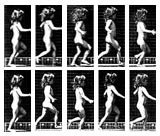| | Web Visualization > | | Chronicle article | Temporal Models | 2D Spacial Models | 3D Spacial Models | Parametric Models | Process Models |
Web Visualization for Teachers: Temporal Models
Alistair B. Fraser
Muybridge's problem
Muybridge’s running boy,
c. 1880, spacial sequenceHe solved it by employing as sequence of separate cameras which took pictures in very rapid succession. (This was prior to the invention of the movie camera (1889) by Thomas Edison), sequences of still images (taken by a succession of cameras) were used to record motion. He then spread the separate images out in space. This approach provided information, but mentally integrating the separate images spread out in space(as with the small boy to the left) was not nearly as easy as if they had been presented in time. So, Muybridge build a movie projector to present the images in time (animated gif to the right). He was thus able to learn the motion of things which were not easily obtained by just watching them. (He even managed to settle bets this way).
temporal
sequence
Timelapse
cumulus clouds
sped up 300 XThe problem Muybridge faced is similar to that encountered by modern meteorologists who view a sequence of weather maps or satellite pictures. It is much easier to grasp the temporal behavior when they are presented as a movie with roughly the same temporal resolution as the human eye than as a spacial sequence. Mind you, Muybridge was concerned with representing rapid motion at a comfortable resolution; the meteorologist is usually more concerned with presenting very slow motion this way --- a process known as timelapse photography. I illustrate timelapse by showing the growth of cumulus clouds. (The movie to the right requires QuickTime ). What would have appeared to the eye as a series of separate unrelated scenes is now revealed as a sequence of bubbles of cloudy air rising above the mountain, each successive one climbing higher than the last.
Morphs
ice crystal
metamorphismA few years ago, morphs became popular as a way to build transitions between forms for which nature offers no examples. However morphs have pedagogical uses. For example, one frequently has a sparse set of images showing the way something evolves. Such images are normally presented in a spacial array (e.g., the array of pictures of the boy walking, above). But if the data are sparse, a direct transformation into a movie results in an unsatisfactorily jerky presentation. The alternative it to build a single morph. This I have done for a sequence of drawings of the metamorphism of a ice crystal in a snow pack (an evolution from a dendrite to a rounded grain). It approximately reconstructs what might have been seen if a timelapse had been available. The technique can also be applied to the building of a smooth transition between states which are not normally joined in such a simple manner. Examples might be the smooth aging of a person from baby to octogenarian built from a half dozen portraits taken throughout life, or the evolution of the ozone hole in Octobers (thus ignoring the intermediate states).
The tools
There is no denying the power of movies to familiarize one with the temporal behavior of nature. And beyond the overwhelming use of them to represent time on a one-to-one scale, there are powerful means of portraying time using either a very high frame rate or a very low one.
Such techniques have been available to teachers, at least in principle, for a long time. However the images were difficult to create, and awkward to show in or out of class. Most teachers rarely bothered. To take timelapse movies of clouds in the 1960s, I had to borrow rare, expensive, and heavy equipment. I then spent money on film and processing, and yet only had a small chance that the result would be useful. The cloud sequence (above) was captured on a digital video camera which fits in my shirt pocket. I set it on a chair and walked away for an hour or so. The results were examined and edited on my portable computer within minutes of turning off the camera. Unsuitable portions were erased (at not cost) and the rest is available in multiple sizes and lengths for use in class or over the web with virtually no overhead to my regular preparation.The tools now are a digital video camera and a way to get images in the computer. You can use movie editing software, but it is usually not necessary (I just use QuickTime, itself), as those expensive packages provide one with cute splicing and transition effects, but these are not very germane to the basic issue of communicating the temporal behavior of nature.
On the web, one can employ something as simple as an animated gif (the format used for the running child, above). Many inexpensive programs (some are free) can turn a sequence of images into an animated gif. This has the advantage of being seen on a web document even without a plugin, but the user cannot interact with it even to stop or start it, let alone step through single frames. For those capabilities (and a whole lot more) one must move to something like QuickTime, MPEG, or AVI. But all of those are easy to work with now.
The basic message is that the opportunity cost of using digital movies to help students build temporal mental models is now so low as to make their construction more a matter of pedagogical imagination than one of cost and inconvenience.
Note: The images of Muybridge, above, are in the public domain.
| Web Visualization > | Chronicle article
| Temporal Models
| 2D Spacial Models
| 3D Spacial Models
| Parametric Models
| Process Models


